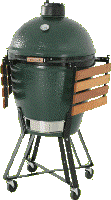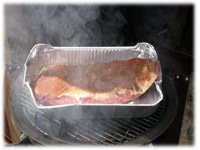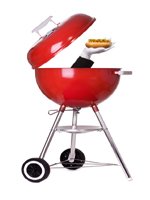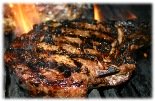
Charcoal Grill Tips - learn how to prepare & use your charcoal grill
Charcoal or Gas grill? If possible I think people should have both - charcoal for those long, low and slow barbecue sessions and gas for the quick grilling convenience.
The majority of people today are using just gas grills (due to marketing and convenience) but charcoal grills are still the #1 choice among professionals and people who have a real passion for BBQ.
There is a growing resurgence lately in the popularity of charcoal barbecues and smokers and more retailers are offering a wider variety of choices.
Nothing can compare to charcoal for burning hotter and providing that traditional smokey barbecue flavor.
They're a little more work than gas grills so some charcoal grill tips might be useful.
We've discussed lump charcoal and charcoal briquettes here and when to use either type.
On this page let's talk about these charcoal grill tips...
- How much charcoal do I need?
- How do I light a charcoal grill?
- Temperature control for charcoal grilling
- How to setup a charcoal grill for Direct grilling
- How to setup a charcoal grill for Indirect grilling
- How to I get a longer burn time (more than 4 hours)
How much charcoal do I need?
This really depends on the size of your grill.
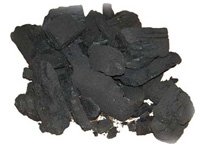
The standard kettle grill is about 22" in diameter.
A load of between 80 to 100 briquettes is enough to build a single layer across 2/3 of the bed of the grill.
This equates to a full load for most large charcoal chimney starters.
This also provides you with both a hot zone and cooler zone for grilling your food.
These coals should last between 45 and 60 minutes before you need to replenish them with more coals.
If you're using lump charcoal then fill the charcoal chimney starter with as much as you can and fill in any gaps with more pieces after you've dumped them in the grill bed.
If you don't have a chimney starter for measuring then do the best you can to make the bed 2/3 across in a single layer.
I'll discuss different arrangements and distribution of the coals further down this page.
Hot Tip - the coals should extend at least 4" beyond each piece of food your grilling to ensure even cooking.
How do I light a charcoal grill?
No lighter fluid please. It's really a thing of the past (even though when I smell it I'm transported back in time to my Dad's BBQ...).
I've some interesting memories watching people mis-use this stuff. Not only that but it can give off fumes - when raw food is first put on a grill it's most susceptible to absorbing smoke and fumes - so you don't want your beef brisket to taste like jet fuel, right?
Let's look at 3 methods to light your charcoal grill...
1. Charcoal Chimney starters: These are good for both lump charcoal and charcoal briquettes. Chimney starters come in all shapes and sizes - Weber has a nice one that can hold more charcoal than most others (up to 6 lbs).
Get the biggest one you can find, you don't always need to load it full but when you do you'll be happy to have the capacity.
Basically a charcoal starter is a metal cylinder with handles and a charcoal grate mounted inside.
Here's an easy way to use a charcoal chimney starter...
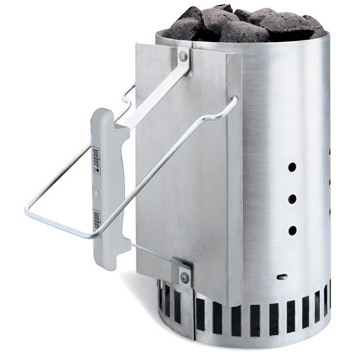
- Roll 2 or 3 pieces of newspaper into small rolls.
- Insert these rolls in the bottom of the starter in a circle leaving a hole in the middle to provide better airflow.
- Fill the top portion with either lump charcoal or briquettes.
- Light the paper and set the chimney either on the charcoal rack in your grill or on fire-proof bricks (not on wood or cement, the wood's obvious but it will ruin cement).
If you’re doing a regular burn (2-4 hours) then you can load up the starter with as much as it will hold.
If you’re doing a longer burn (see below) then only load 15-20 pieces.
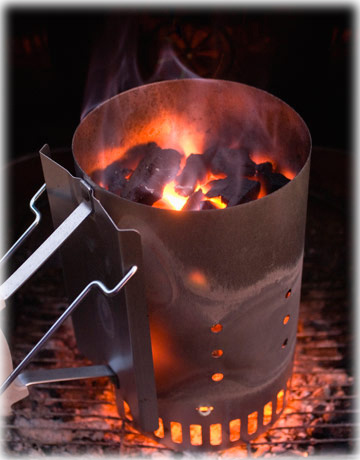
With the newspaper lit the starter uses the convection chimney effect to ignite the charcoal. Give it about 15-20 minutes to get all the charcoal lit and glowing.
When you see flames licking at the top and gray ash starting to form on the top briquettes it's ready.
Leave it too long and the charcoal on the bottom will be burnt out.
When it’s ready, turn out the hot coals into the grill charcoal chamber or onto the rest of the charcoal in the grill (if doing the long burn method below).
The chimney will still be hot so be careful where you set it!
2. Electric charcoal starters: If you don't have or want a charcoal chimney starter and you've access to electricity a clean simple solution is an electric charcoal starter.
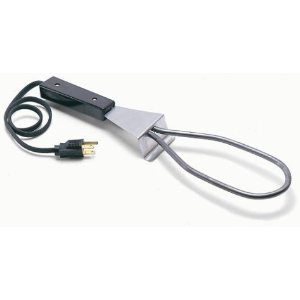
These inexpensive units are available at most grilling stores and even most big box hardware stores today.
Simply bury the heating element end in the charcoal, plug it in and wait 7-10 minutes. It will glow read and begin to ignite the charcoal it's buried in.
Unplug the charcoal starter, remove it and put it in a safe location until it cools.
Please be careful, you or a bystander can get a pretty bad burn if you come in contact with the heating element.
3. Parafin fuel cubes
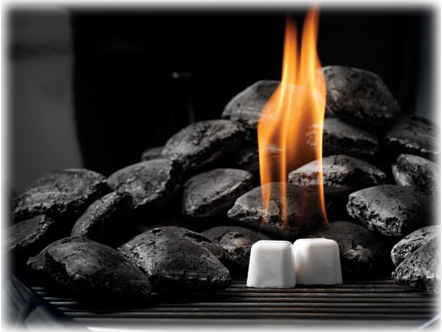
What if you don't have a charcoal chimney or electric starter?
Buy some parafin fuel cubes from most big-box hardware store or BBQ centers.
Build a pyramid of charcoal (lump or briquette) over several of these fuel cubes and light the cubes. Once the coals are ready then distribute them the way you need them (see below).
It usually takes about 20 minutes for the coals to glow orange and be ready for distribution across the grill bed.
Temperature control for charcoal grilling
Of the charcoal grill tips - the two most important tips to get right in BBQ & grilling is getting the grill to the recipes recommended cooking temperature and then controlling that temperature.
Depending on the type of food you're grilling determines how you set-up your charcoal in the grill and get it up to temperature.
See further down the page how to set-up for Direct and Indirect charcoal grilling and different temperature zones.
Once you've reached your target cooking temperature the next trick is to maintain it.
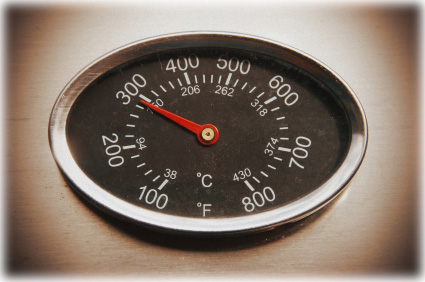
Controlling the temperature of charcoal grills takes a bit more effort then gas grills.
With most charcoal grills you need to adjust upper and lower vents and when temperatures drop, replenish the charcoal with new, already lit charcoal to keep the temperature where you want it.
It's also important to remember that the longer the coals burn, the cooler they get.
I know it sounds pretty obvious but you really need to pay attention to this fact.
Plan ahead and if doing a longer burn you should get the coals ready in a charcoal starter to replenish before you need them and not after it's too late.
Adding unlit briquettes could give off odors that may be picked up by the food. Lump charcoal has less chance of this when added unlit.
Even just 1 hour after starting you can lose up to 100F cooking temperature with charcoal grilling. Count on adding 15-20 briquettes or lump every hour or so.
Usually coals are ready to cook on 20 or 30 minutes after they've been lit.
Also, keep the lid down while charcoal grilling but monitor and adjust the lid vent and bottom vents.
It's much easier to add heat to a charcoal fire then it is to bring the heat down.
If your grill comes equipped with a temperature gauge in the hood then use that - it should be good to +/- 20 degrees.
If not, here is another of the charcoal grill tips to get an idea how hot your grill is:
Hold your bare hand about 4" to 5" above the grill and start counting "1-Mississippi, 2-Mississippi, 3-Mississippi, 4-Mississippi, OUCH!"
Sooner or later you have to pull your hand away due to the heat.
Use these guidelines to judge the approximate heat:
- 2 to 3 Mississippi = High heat or 450f to 650F
- 4 to 5 Mississippi = Medium-High heat or 400f
- 6 to 8 Mississippi = Medium heat or 325F to 350F
- 9 to 10 Mississippi = Medium-Low heat or 300F
- 11 to 14 Mississippi = Low heat or 225 to 250F
How to set up for Direct charcoal grilling
Lump charcoal burns hotter and faster than charcoal briquettes so it may have an advantage to the quicker direct charcoal grilling method.
You'll use the direct grilling method for shorter, hotter burns and when you're grilling steak, making grilled chicken recipes, pork chops, grilled vegetable recipes, etc.
Once the charcoal is burning and ready for grilling arrange it into 3 different sections or zones on the grill.
You can use anything to move the coals around that isn't flammable and has a long enough handle to keep your hands and arms away from the heat.
You can use BBQ tongs if you've nothing else.
3-Zone method:
Arrange a double layer of hot coals over 1/3 of the grill bed.
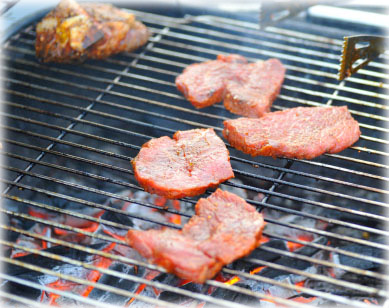
Use this highest heat zone to sear the meat.
Zone 2:
Arrange a single layer of hot coals over another 1/3 of the grill bed - in the center or to the edge.
Use this zone to continue lower heat cooking while you add more food to the hot zone.
Zone 3:
Keep the last 1/3 of the grill bed empty with no coals.
Use this zone when some of the food is cooked and you want to keep it warm while the rest of the food cooks.
If you find the charcoal is burning out before the end of the cooking time you can add more using a couple different methods:
- Either arrange what's left of the burning charcoal into a pile in the center and add fresh lump charcoal or briquettes on top of the pile or
- Fire up another load of charcoal in the charcoal starter and when ready dump on the burning charcoal. The chimney should be started 15-20 minutes before you actually need it if possible.
How to set up for Indirect charcoal grilling
Charcoal briquettes burn longer than lump charcoal so they have an advantage with longer indirect grilling (2 to 4 hours).
For indirect charcoal grilling the food isn't placed directly over the heat but is cooked next to it.
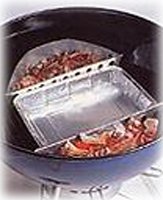
This method is used for larger cuts of meat and recommended in the;
- Sweet & Sticky bbq ribs recipe
- Low & Slow BBQ beef brisket
- Roasts like the great grilled Prime Rib
- Larger birds and the famous Beer Can chicken
And the traditional Pulled Pork recipe.
This method generally requires a longer burn time so you may have to replenish the charcoal more often unless you follow the longer burn method described further below.
For indirect charcoal grilling, light the coals using either an electric charcoal starter, a charcoal chimney starter or parafin fuel cubes.
When the coals are ready arrange them in two equal piles on each side of the charcoal grill bed leaving the center open.
Some grills come equipped with charcoal baskets or dividers just for this purpose.
Place an disposable aluminum drip pan in the center between the charcoal. This helps keep the charcoal to the sides and also catches the drippings from the meat as it grills.
How to set up for longer charcoal burning times
Here is one of the best charcoal grilling tips if you're planning on a longer burn time (more than 4 hours) using charcoal briquettes.
Arrange your grill bed with unlit briquettes evenly spread and deep enough for a longer burn, at least 2 - 3 layers.
Using a charcoal chimney starter fire up a small batch of briquettes (15-20).
Spread these hot briquettes over the unlit briquettes and close the lid.
These lit briquettes will slowly ignite the unlit ones over a longer period of time.
You want to adjust the top and bottom air vents to get the grill to a range of 225-275F - monitor the air flow and temperature to keep it steady around this range.
Using the bottom vents, carefully control the amount of air entering the cooker to keep the fire burning low and steady.
It's easier to control this type of a burn then it is to bring a full-out burn down to a lower temperature.
Enjoy!
Back to Top
Home › Barbecue Tips › Charcoal Grill Tips
